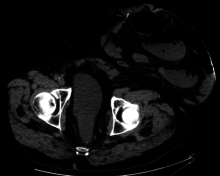Colostomy
| Colostomy | |
|---|---|
| Intervention | |
 Diagram showing a permanent colostomy | |
| ICD-9-CM | 46.1 |
| MeSH | D003125 |
| MedlinePlus | 002942 |
A colostomy is a surgical procedure in which an opening (stoma) is formed by drawing the healthy end of the large intestine or colon through an incision in the anterior abdominal wall and suturing it into place. This opening, in conjunction with the attached stoma appliance, provides an alternative channel for feces to leave the body. It may be reversible or irreversible depending on the circumstances.
Indications
There are many reasons for this procedure. Some common reasons are:
- A section of the colon has been removed, e.g. due to colon cancer requiring a total mesorectal excision, diverticulitis, injury, etc., so that it is no longer possible for feces to exit via the anus.
- A portion of the colon (or large intestine) has been operated upon and needs to be 'rested' until it is healed. In this case the colostomy is often temporary and is usually reversed at a later date, leaving the patient with a small scar in place of the stoma. Children undergoing surgery for extensive pelvic tumors commonly are given a colostomy in preparation for surgery to remove the tumor, followed by reversal of the colostomy.
- Fecal incontinence that is non-responsive to other treatments.
Options

Placement of the stoma on the abdomen can occur at any location along the colon, but the most common placement is on the lower left side near the sigmoid where a majority of colon cancers occur. Other locations include the ascending, transverse, and descending sections of the colon.[1]
- Loop colostomy: This type of colostomy is usually used in emergencies and is a temporary and large stoma. A loop of the bowel is pulled out onto the abdomen and held in place with an external device. The bowel is then sutured to the abdomen and two openings are created in the one stoma: one for stool and the other for mucus.
- End colostomy: A stoma is created from one end of the bowel. The other portion of the bowel is either removed or sewn shut (Hartmann's procedure).
- Double barrel colostomy: The bowel is severed and both ends are brought out onto the abdomen. Only the proximal stoma is functioning.
Colostomy surgery that is pre-planned usually has a higher rate of long-term success than surgery performed in an emergency situation.
People with colostomies must wear an ostomy pouching system to collect intestinal waste. Ordinarily the pouch must be emptied or changed a couple of times a day depending on the frequency of activity; in general the further from the anus (i.e., the further 'up' the intestinal tract) the ostomy is located the greater the output and more frequent the need to empty or change the pouch.[4]
Colostomy with irrigation
People with colostomies who have ostomies of the sigmoid colon or descending colon may have the option of irrigation, which allows for the person to not wear a pouch, but rather just a gauze cap over the stoma, and to schedule irrigation for times that are convenient.[5] To irrigate, a catheter is placed inside the stoma, and flushed with water, which allows the feces to come out of the body into an irrigation sleeve.[6] Most colostomates irrigate once a day or every other day, though this depends on the person, their food intake, and their health.
Alternatives
A man in the UK has been given a remote-controlled bowel.[7] Colostomy or ileostomy is now rarely performed for rectal cancer, with surgeons usually preferring primary resection and internal anastomosis,[8] e.g. an ileo-anal pouch. In place of an external appliance, an internal ileo-anal pouch is constructed using a portion of the patient's lower intestine, to act as a new rectum to replace the removed original.
Routine care
A pouch that can be drained is usually emptied when it is one third full.[9] A pouch is replaced usually every 3 to 7 days or whenever the seal comes off, for which it should be replaced immediately.[9]
Complications

Parastomal hernia is the most common late complication of stomata through the abdominal wall, occurring in 10 to 25% of the patients.[10]
See also
References
- ↑ Potter et al. Canadian Fundamentals of Nursing 3rd ed.2006, Elsevier Canada.p1393
- ↑ Potter et al. Canadian Fundamentals of Nursing 3rd ed.2006, Elsevier Canada. p1393-1394
- ↑ http://oncolex.org/Colorectal-cancer/Procedures/TREATMENT/Kirurgi/Stoma?lg=procedure
- ↑ "Colostomy irrigation: Colostomy Guide" (PDF). United Ostomy Associations of America. Retrieved 4 February 2013.
- ↑ Rooney, Debra. "Colostomy irrigation: A personal account managing colostomy" (PDF). Ostomy. Retrieved 7 September 2012.
- ↑ Wax, Arnold. "What is colostomy irrigation?". WebMed. Retrieved 7 September 2012.
- ↑ Man-uses-remote-to-control-his-bionic-bottom The Telegraph]
- ↑ al.], senior editors, Bruce G. Wolff ... (2007). The ASCRS textbook of colon and rectal surgery. New York: Springer. p. 417. ISBN 0-387-24846-3.
- 1 2 Taylor, C. R., Lillis, C., LeMone, P., Lynn, P. (2011) Fundamentals of nursing: The art and science of nursing care. Philadelphia: Lippincott Williams & Wilkins, page 1327.
- ↑ Paul H. Sugarbaker (2013). "Paraostomy Hernias: Prosthetic Mesh Repair". Abdominal Surgery. American Society of Abdominal Surgeons.